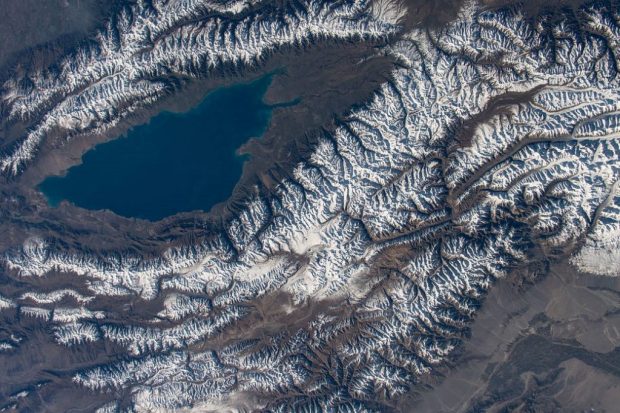United Nations adopts “Sustainable Mountain Development” resolution initiated by Kyrgyzstan

The United Nations General Assembly in progress (Kabar)
NEW YORK: In an international diplomatic and ecological success for Kyrgyzstan, the United Nations General Assembly (UNGA) has adopted a “Sustainable Mountain Development” resolution.
Initiated by Kyrgyzstan, a Central Asian country with mountains forming 94% of its landscape and that has championed for the mountain sustainability concept, the resolution declared 2023-2027 “Five Years of Action for the Development of Mountain Regions.”
The resolution was adopted unanimously without a vote, and 109 UN member states have become its co-sponsors, a Kyrgyz foreign ministry statement said.
“The Assembly took up the report “Sustainable mountain development” (document A/77/443/Add.11), adopting the eponymous resolution without a vote, stressing the special vulnerability of people living in mountain environments, in particular local communities and indigenous peoples, and invite States to strengthen cooperative action,” the UN said its press release.
“It also decided to proclaim the period 2023-2027 as ‘Five Years of Action for the Development of Mountain Regions’ to enhance the international community’s awareness of the problems of mountain countries and to give new impetus to the international community’s efforts to address the challenges and problems of mountain countries.”
The initiative to announce the “Five Years of Action for the Development of Mountain Regions” was launched by Kyrgyz President Sadyr Zhaparov who voiced it at the General Debate of the 77th session of the UN General Assembly in September 2022, Kabar News agency reported.
According to reports, the plan calls for mountain-specific measures, mitigation, and sustainable development strategies to tackle mountain-specific problems caused by climate change.
The plan also calls for international cooperation in bringing mountain sustainability to the surface.
For Kyrgyzstan, the call is for a multi-stakeholder participation in the five-year plan that includes addressing the mountain-related problems from the economy, education, culture, and environment.
The success of the plan crucially requires participation from all related stakeholders that include international and national organizations, the government, businesses, and scientists and with the aim of creating sustainable living for everyone, everywhere, without exceptions.
The foreign ministry and several institutions have conducted a large-scale campaign for the practical implementation of this initiative.
On the sidelines of the UNGA High-Level Week of the 77th session, the Kyrgyz Republic held a High-Level Meeting on Sustainable Mountain Development.
The final statement of this Meeting was adopted as an official document of the UN General Assembly and calls on the UN member states to support the resolution.
The announcement of the “Five Year Plan” opens up wide opportunities for attracting grant assistance and investments in the economy of mountainous countries, including the Kyrgyz Republic, the development of a “green” economy and technologies, the creation of financial mechanisms to strengthen cooperation between mountainous countries, the development of science and education in sustainable mountain development.
It also allows for the implementation of projects and programs in counteracting the negative effects of climate change, conservation of biological diversity and prevention of natural disasters in mountainous regions.
Although mountains are among the most vital water producers and the home of many biodiversity and indigenous communities, they are not immune from the impact of climate change, just like other natural landscapes.

Kuban
Addressing the World Journalist Conference on April 20, 2021, Kabar News Agency former Director General Kuban Taabaldiev warned against effects on large reserves of glaciers in Tajikistan and Kyrgyzstan.
“The mountains of these countries accumulate almost 90% of the region’s glaciers, which have remained unchanged for centuries,” Taabaldiev said.
“The water reserves in the two countries are accumulated by glaciers melting in summer formed all account regional reserves. In other words, the glaciers of these two countries constitute the main source of drinking and irrigation water. The water flows of the Amu Darya River originate in the mountains of Tajikistan and run through the territory of four neighboring countries, the Naryn River, formed in the mountains of Kyrgyzstan, becomes the Syr Darya River. About 40 years ago, these rivers flowed into Lake Aral and kept its level in balance. Due to the melting of glaciers, the total area of glaciers in the two countries has decreased by 30%.”
Because of this, the inflow of water from the mountains into the main rivers of the two countries, the Amu Darya and the Syr Darya has significantly decreased, he added.

Issyk-Kul Lake from Space (commons.wikimedia.org)
“The decrease in water inflow in the summer is a matter of concern for the authorities of the two countries – if 15-20 years ago Kyrgyzstan and Tajikistan were considered as exporting countries of electricity, now, due to a lack of water in the winter, both Kyrgyzstan and Tajikistan are forced to buy electricity from their neighbors. This is only one of many consequences of climate change in the region,” he said in his presentation.
Taabaldiev referred to Lake Issyk-Kul, famous in Central Asia as an increasingly attractive destination for tourists.
This lake is surrounded by high mountains, up to 5000 meters high. The peaks of these mountains have always remained covered with ice, even in the hottest summer months.
“However, in the past 10 years, scientists are noticing more frequently that the mountains around the Lake appear to be without glittering glaciers. They note that for the Issyk-Kul basin, with a 1° increase in temperature, the ice area on the southern mountain ranges will decrease by 19%, and on the northern ridge – by 5%,” he said.
“And if the temperature increases by 2° – the size of the glaciers on the southern slope of the mountains will decrease by 76% and on the northern slope by 32%. In other words, scientists fear that overheating in the valley may lead to an imbalance in water flows, more water will drain in the south of the lake and lead to a decrease in glaciers, and vice versa – in the north of the lake, rivers will become shallower, the volume of water will decrease faster. And this is steadily leading to natural disasters.”
As a result of climate change, there is an increase in mudflows, landslides, and avalanches. In Kyrgyzstan alone, there are more than 5,000 different hazardous areas prone to landslides.
“The danger of landslides in mountainous regions of the two neighboring states will accelerate due to climate change. Moreover, more than 60% of the population lives on the mountain slopes. Over the past 30 years, both Tajikistan and Kyrgyzstan have suffered from massive landslides, in which people died, and some settlements simply disappeared under the rubble.”

























































